JB74 gear ratios and gearing
This is an evolving page, but is brought about as I’m seeing more and more people share a couple of quick graphs I made up. Eventually I’d like to make it easier to do your own gearing calculations especially for reduction gearing and large tyre combinations, but for now you can all cope with some graphs while I work on the back end tech.
Sections
- Specifications
- Road speeds and revs – auto and manual
- What does this mean for how they drive?
- High and low range gearing and speeds
- Changes with larger tyres
- Reduction gearing
- Deeper dive: apparent thrust
- Effect of converter ratio
- Nerdy stuff: how to calculate this sort of thing
Specifications
This comes up a lot as the auto and manual diff gears and transfer case differ from generation 3 Jimnys. I have based this off the official Suzuki Australia specifications, supplemented with Suzuki New Zealand who bother to also publish the transfer case ratios. Stall ratio is from the workshop manual. I’m confident they are correct, and they perfectly correlate with speeds and revs in the real world. Auto and manual diffs and also transfer cases have different part numbers, too, so they’re definitely not the same.
This information is true for at least 2019 through 2023 Jimnys. I’ll update it if things change.
| Manual JB74 | Automatic JB74 | |
|---|---|---|
| Stall ratio / speed | N/A | 1.85:1 2 050 – 2 650 rpm |
| 1st | 4.42:1 | 2.88:1 |
| 2nd | 2.3:1 | 1.57:1 |
| 3rd | 1.67:1 | 1:1 |
| 4th | 1.19:1 | 0.7:1 |
| 5th | 1:1 | N/A |
| High range | 1:1 | 1.32:1 |
| Low range | 2:1 | 2.64:1 |
| Differential | 4.09:1 | 4.300:1 |
The gearing often prompts people to ask questions like “does the auto rev a lot more on the highway than the manual?” or “wouldn’t the auto be better due to the overdrive top gear?”. It’s worth understanding how all the gearing interracts rather than just looking at one specific ratio within the whole set.
Road speeds and revs – auto and manual
Fortunately it’s all very easy to calculate out how gearing works in terms of what engine speeds give you what road speeds. Right at the bottom of the page I explain the details behind this if you wanna get extra nerdy.
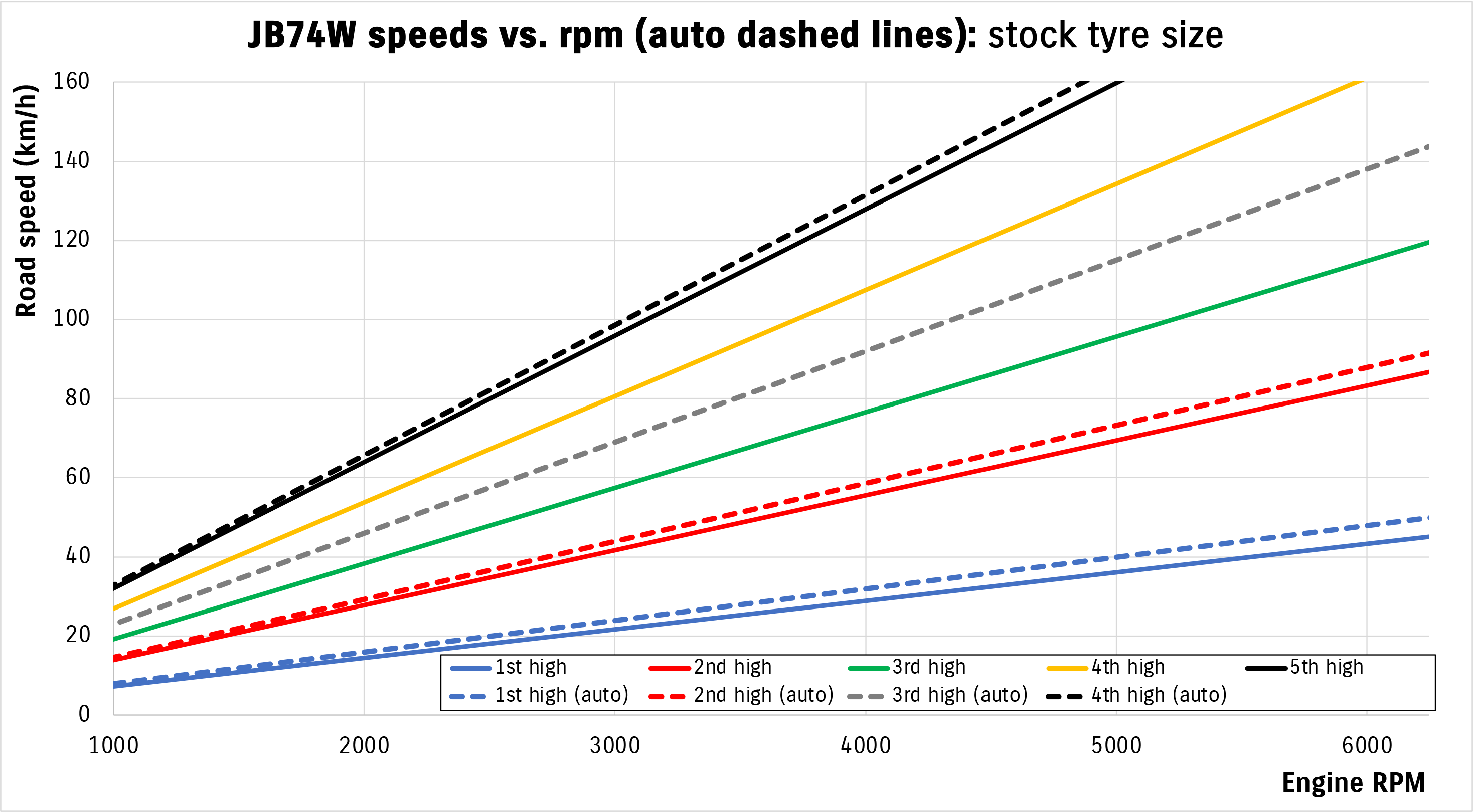
What does this mean for how they drive?
People really get hung up on the potential differences between the auto and the manual. It’s understandable, given a 4 speed auto or 5 speed manual is kind of antiquated for a ‘new’ 2020s car, but ultimately it’s closer than people think between the two transmissions. Fundamentally though:
1. The auto and the manual aren’t much different on the highway.
The overall gearing works out to be basically identical in the respective top gear for each transmission type. The auto revs marginally less when the converter is locked up at highway speeds, but it’s fractional (~40 rpm at 110 out of 3300 or so…: i.e. 1% different).
Going up hills it might get a bit complicated to know what’s best. In the manual you have a choice of 2 gears to go back to, whereas the auto can only drop to 3rd practically at highway speeds. If you have a moderate hill, though, the torque converter can unlock and remain in 4th which will give you a few more revs and torque, at the expense of using a bit of energy through how torque converters work (hence worse fuel economy). The manual can drop back to 4th or if the hill is particularly steep it can grab 3rd and still maintain highway speed (albeit revving its little heart out), whereas a steep hill is going to see the auto have to slow down enough to go all the way back to 2nd.
I’ll revist this topic a bit in the concept of apparent thrust which is a more technical way to look at how much oomph is being put down to the road.
2. The manual is not that much harder to live with in stop-start traffic.
This is the flipside to the auto being thought of as worse for the highway. The manual’s clutch is very light; the short 1st gear also means you can very easy release the clutch with no throttle and just crawl along in traffic quite easily. The engine being happy to rev also means you don’t need to immediately grab 2nd gear, either. The manual is significantly quicker to accelerate due to the shorter first gear and the direct connection between engine and transmission: a torque converter can soak up a lot of power even if it has the benefit of some torque multiplication.
3. They each have their pros and cons offroad
General thinking many years ago used to be manuals were significantly better offroad as you were locked into the gear you asked for and that was it; autos were prone to upshifting at the wrong time, not downshifting early enough and generally were a lot worse. The advent of modern electronic transmission control – even on ‘old’ 4 speed autos like the Jimny has – really flipped the script so most people now regard autos as better offroad.
Automatic gearboxes are a lot easier to crawl with especially up rocks. The torque converter also acts as a bit of a buffer, smoothing out driveline jerks as you thump over rocks and things. In sand, the auto can downshift as needed especially climbing up dunes and things. In a manual you get what you get; crawl speed is dictated by gearing or your desire to abuse the clutch, and downshifting in sand at speed is not a good idea.
On the flipside crawling down a slope is always much easier in a manual as you let the engine braking and the shorter gearing do the work for you. While the Jimny has hill descent control it does work via the brakes; the less work you have to make the brakes do the better, and the manual will win at this challenge every day of the week where you’re low and slow with the revs and speed.
This leads very nicely to a discussion about how the high and low range gearing works; most people get confused because the apparently much shorter auto low range makes them think it works quite differently.
High and low range gearing and speeds
On the face of it the gearing in high and low range seems quite different. For high range, the manual is 1:1 so what you spin it into the transfer case is what you get out; the auto is a 32% reduction. When you look at low range the manual is 2:1, but the auto is 2.64:1 – surely that means it crawls much slower?
Well, no: basically low range is exactly half the speed of high range for both. It’s that simple. This is how that looks for the manual:
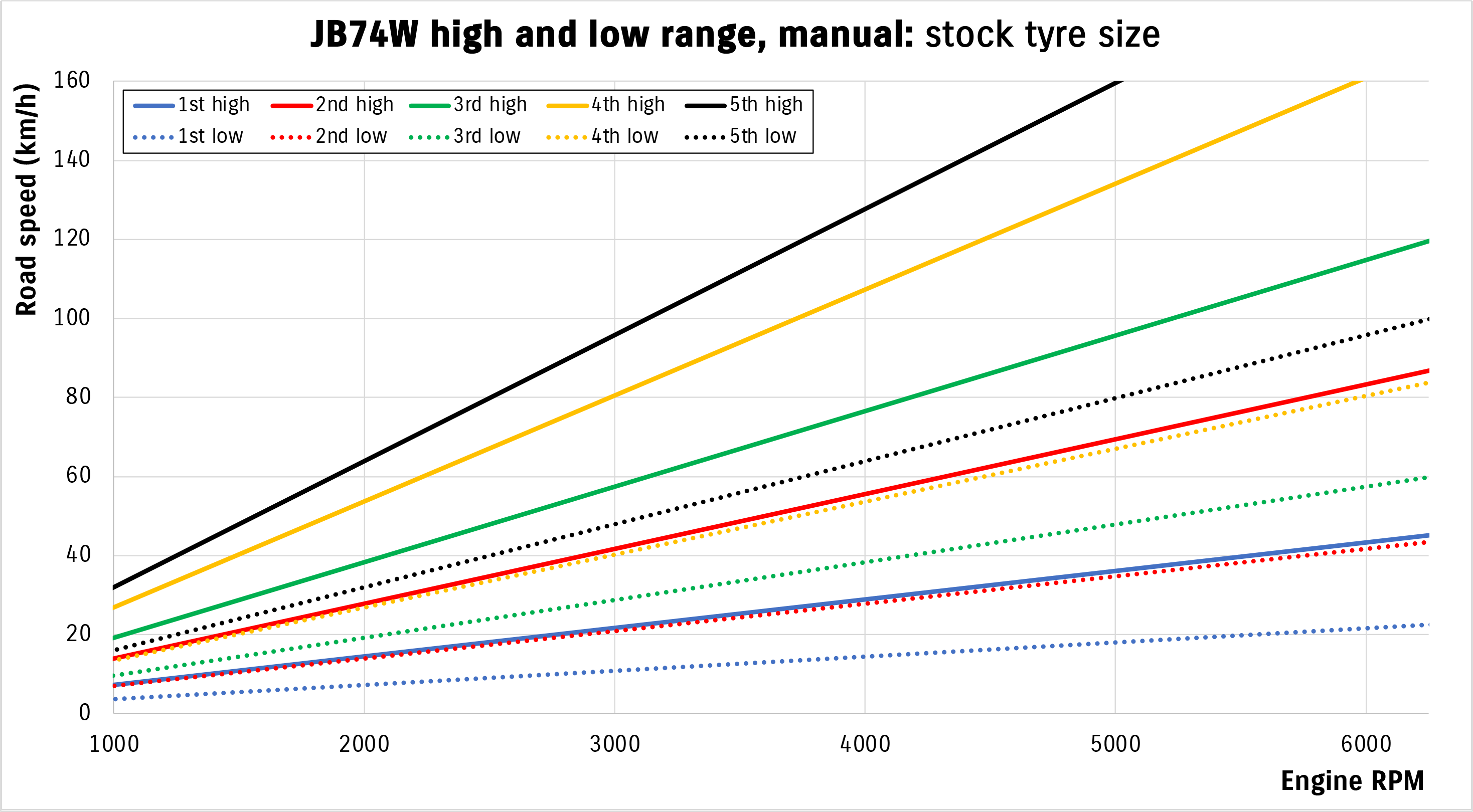
… and how it looks for the auto:
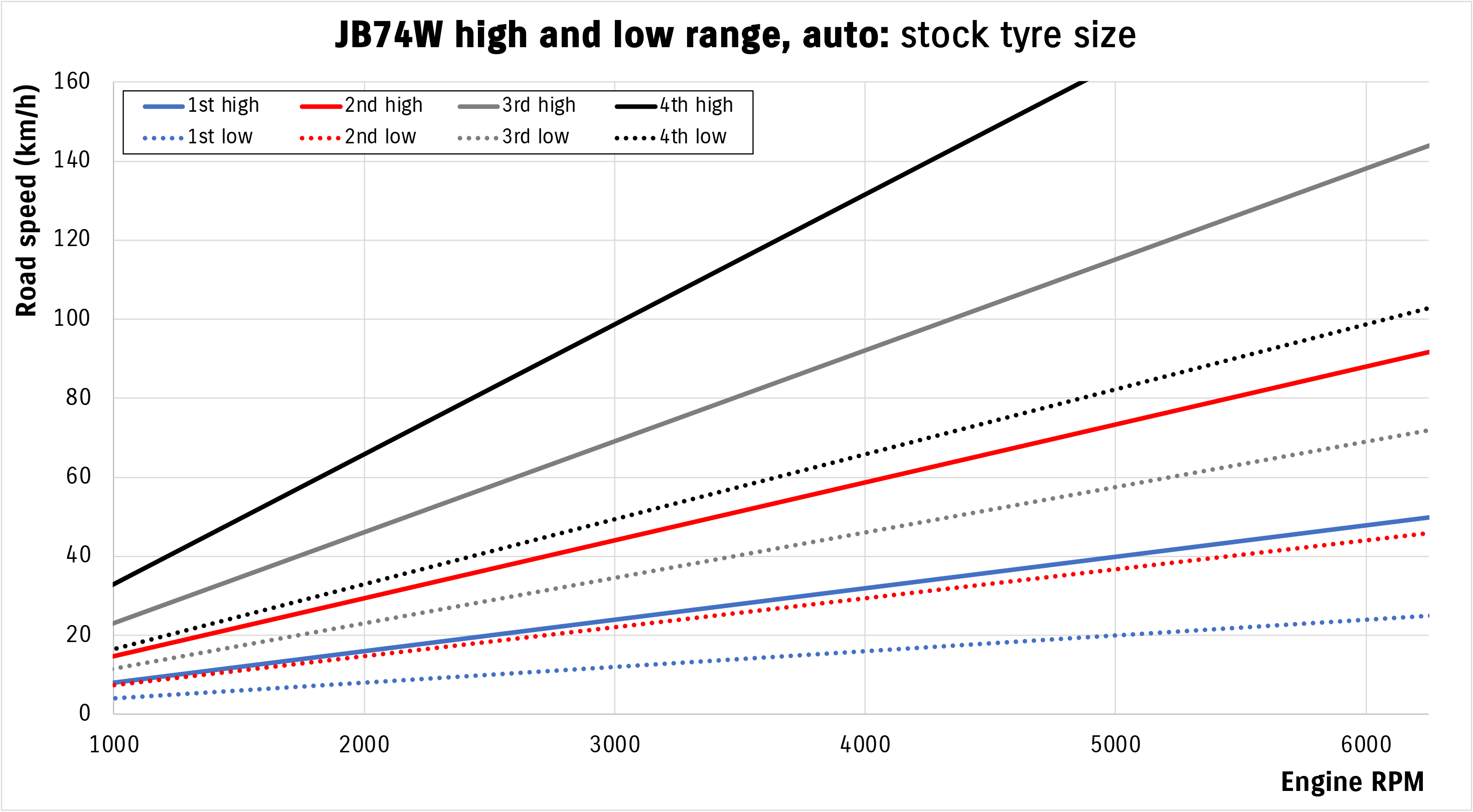
Couple of takeaways here:
For the manual, 2nd gear low is almost exactly first gear high, and 4th low is almost exactly 2nd gear high. In other words, if you think 2nd gear high gives you momentum for a dune run, you can also use 4th gear low for exactly the same momentum, but more flexibility with an option for first-and-a-half as it were.
In the auto it’s a bit more complicated, especially as you can’t really force upshifts in the Jimny (you can use the gear lever to lock it out of upshifting though). Once again 2nd gear in low range is basically the same as first gear high range, but 3rd in low range is quite a bit shorter than 2nd in high range, and 4th in low range is that bit longer. It can be harder to get it to want to upshift into 4th in low range, though, which might make it more limiting to carry momentum. In any case, low range is good (theoretically) for ~100 km/h; while some people vaguely make arguments about windup at high speeds in low range, that’s not exactly how drivelines work either. I certainly have run my car at reasonable speed in low range which is a great way to have ESP off even above 30 km/h, and also gives more flexibility in gear choices for tackling obstacles.
If we zoom in a bit and focus on the kinda most crucial 0-60 km/h zone, here’s what the manual and auto look like just in low range respectively:
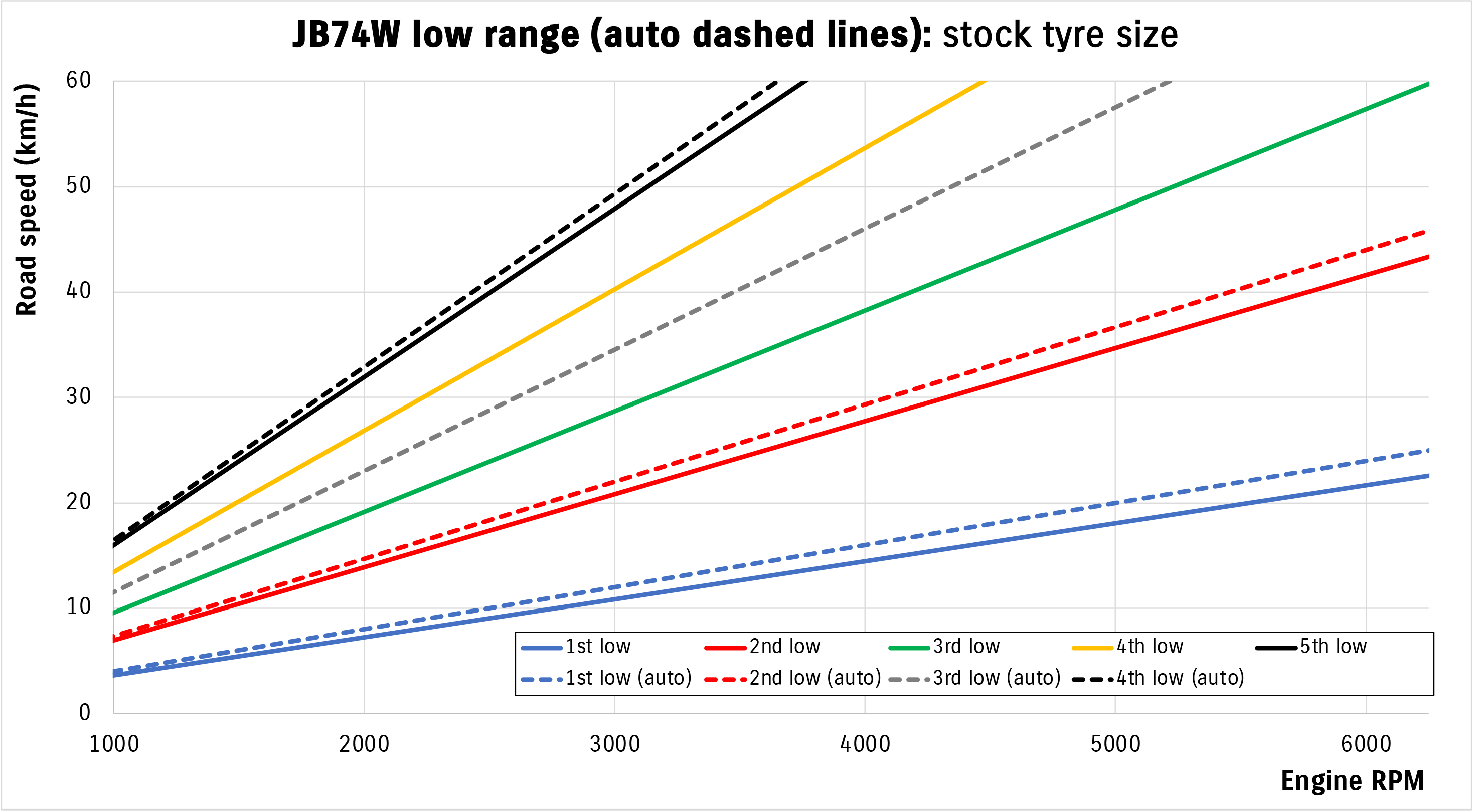
Not much to read into that other than continuing the trend of the manual being marginally shorter both in 1st and also 5th. In addition, practical purposes to sensible speeds offroad 1st through 3rd in the auto (i.e. 4th/overdrive locked out via the switch) and 1st through 4th in the manual are going to be fine in low range. 5th being a direct drive in the manual is a bit of a bonus if you end up ticking along in low range in a slightly quicker section between tricky parts of a track, too.
The other question relates to ‘how do you do gear reduction when the high range is direct drive in the manual?’. Well, ultimately while there’s no gear reduction, the drive for all high range goes through the transfer case chain. The power is just directed through an additional set of gears to give you that 2:1 speed reduction in low range.
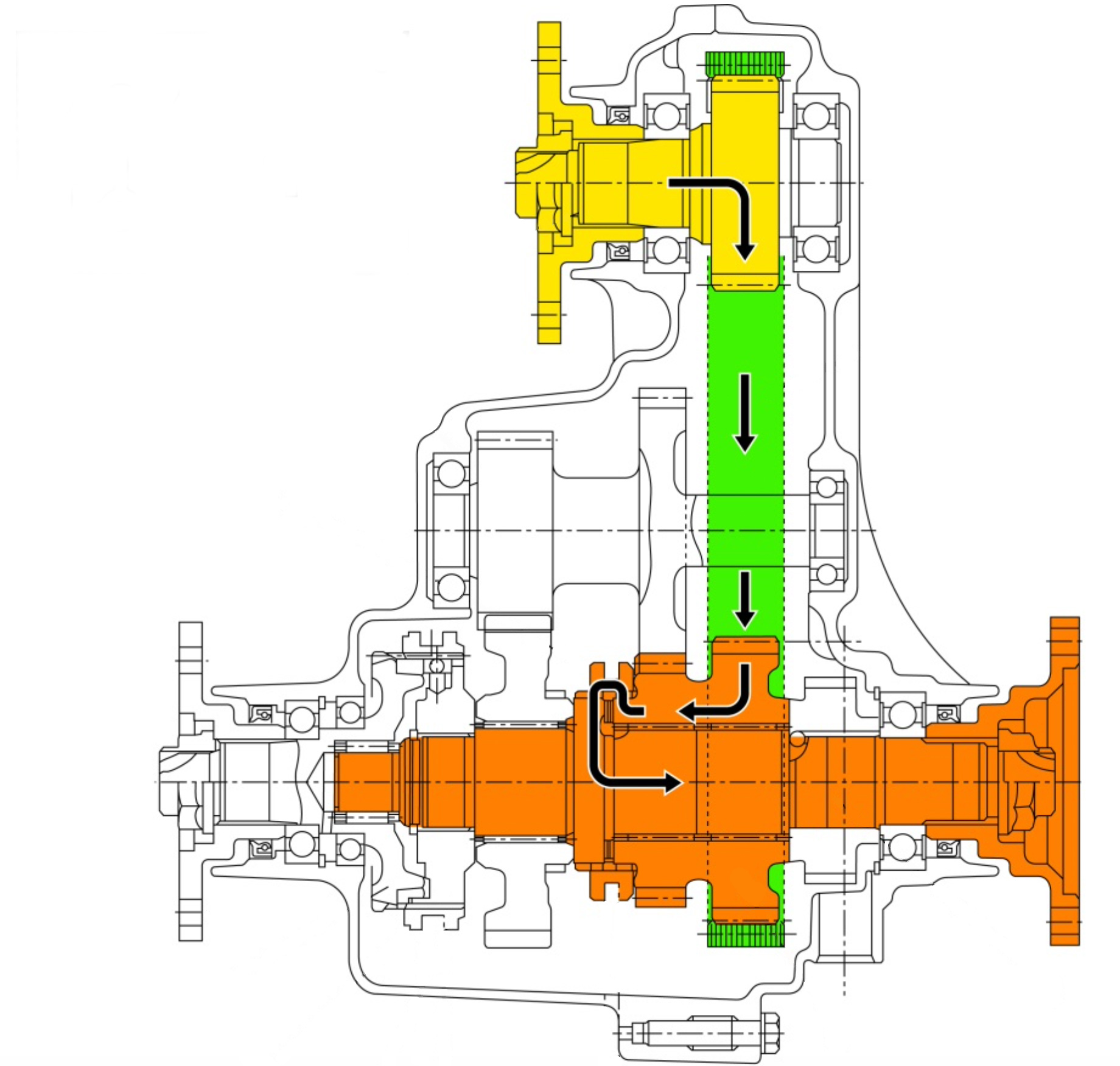
Changes with larger tyres
This isn’t unique to a Jimny – the physics of larger tyres works on every car, surprisingly enough – but it’s worth looking at the specifics of how larger tyres change gearing. Here I illustrate the road speed with factory sized tyres (in grey lines) and also 235/75-15 tyres (5.9% different – coloured lines) for a manual:
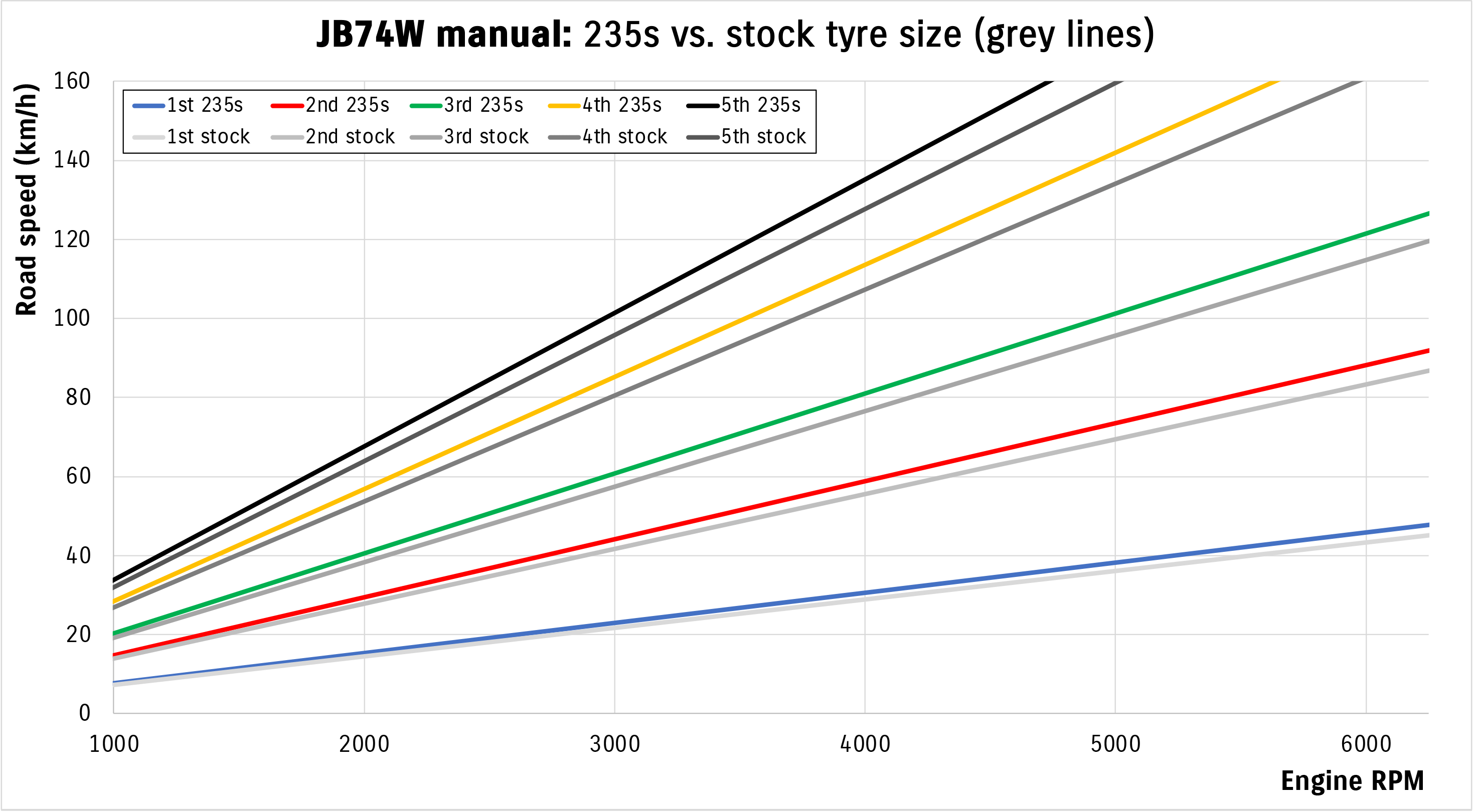
To illustrate the changes with a few different sizes, here’s a zoom in for 60-120 km/h, 2000-4000 ppm, and only 3rd-4th-5th for a few different tyre sizes but still on a manual.
This gets quite hard to visual quickly, but the first thing you’ll notice is that now with 33s 4th gear is where 5th is with the stock car. You think, great! Now I have an extra gear… except you also have shifted the lower gears up, and, it’s not like a Jimny pulls 5th gear with stock tyres that easily anyway. Heavier tyres with a worse overall ratio due to their larger diameter and you’ll be pinging back to 3rd at the smallest incline.
Ultimately the tyre size change is very predictable due to how sizes work. I included the highway speed info and also crawl speeds in my comparison for different tyre sizes. While they do give you lower revs on the highway, you are losing acceleration & the crawl speed offroad is faster for the same revs. This is easiest seen as a table for auto and manual for a few tyre sizes. I look at both what
| Stock 195/80-15 | 215/75-15 | 235/75-15 | 31s | 33s | |
|---|---|---|---|---|---|
| Revs @ 110 km/h: 3rd | Manual: Auto: | ||||
| 4th | Manual: Auto: | ||||
| 5th | Manual: | ||||
| Speed @ 3000 rpm: 3rd | Manual: Auto: | ||||
| 4th | Manual: Auto: | ||||
| 5th | Manual: | ||||
| Speed at 4000 rpm: 3rd | Manual: Auto: | ||||
| 4th | Manual: Auto: | ||||
| 5th | Manual: | ||||
| Speed at 6250 rpm: 3rd | Manual: Auto: | ||||
| 4th | Manual: Auto: | ||||
| 5th | Manual: |
Once you’re into seriously big tyre territory – and I’d class anything over a 29″ tyre on a Jimny as getting there – you need to think about fixing up the gearing to start to help out with things like crawl speed and not having to go back several gears just to get up a minor incline on the highway.
Reduction gearing
With big tyres you’ve got the big tradeoff introduced in the last section: While you’ve gained clearance, your crawl speed is higher and you have less acceleration at your disposal. You’ve also dropped out of the optimum torque range on the highway, making it feel quite sluggish at touring speeds.
Deeper dive: apparent thrust
Effect of converter ratio
Nerdy stuff: how to calculate this sort of thing
People definitely have a deep fear of mathematics in general, but ratios are relatively simple to understand how they work. It’s just a case of chaining everything together. While I’ve previously written little programs to calculate this stuff, this entire article has been based off a quick Excel spreadsheet I made as it’s really straightforwards and you get get nice looking graphs out of it quite quickly if you put in a bit of work up front.
First off, let’s look at how you would calculate road speed in a particular gear given RPM. I’ll illustrate this using 2nd gear, in high range, in the auto to give you all a practical example. I’ll do this at a reference RPM of 3000, too.
The first port of call for the engine’s speed is to go through the transmission. In 2nd gear for the auto this is a reduction of 1.57:1. This means the engine spins 1.57 times to make the transmission output spin once. In other words, the revolutions per minute of the engine is slowed down by a factor of 1.57. At 3000 rpm this means the engine is spinning 3000 times a minute, and the gearbox 3000/1.57 or 1910.8 revolutions per minute.
Gearbox output speed = gearbox input speed / ratio for selected gear
Since the gearbox input speed is the engine rpm, this is also equivalent to
Gearbox output speed = engine rpm / ratio for selected gear
The next stop is the reduction through the high range gear set. In the auto this is 1.32:1. Again, we divide the input speed by the transfer ratio – giving us a transfer case output speed of 1910.8/1.32 or 1447.6 revolutions per minute.
Transfer output speed = transfer input speed / ratio for transfer gear
However, we know that the transfer input speed is equal to the gearbox output speed, so we can also say
Transfer output speed = (engine rpm / ratio for selected gear) / ratio for transfer gear
From the transfer case
